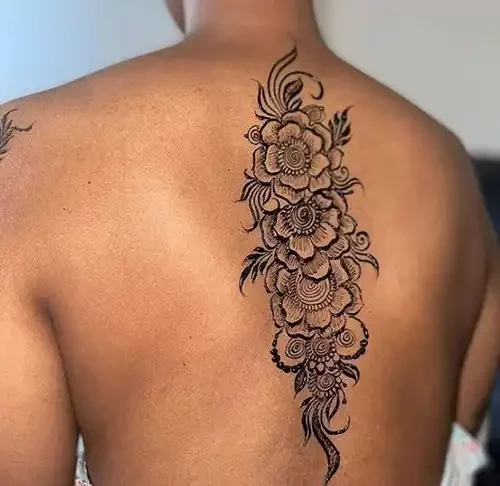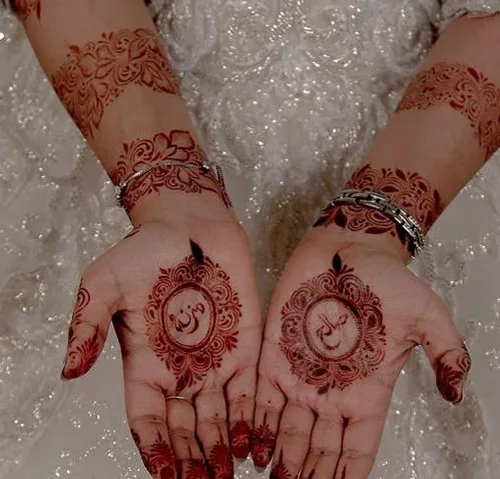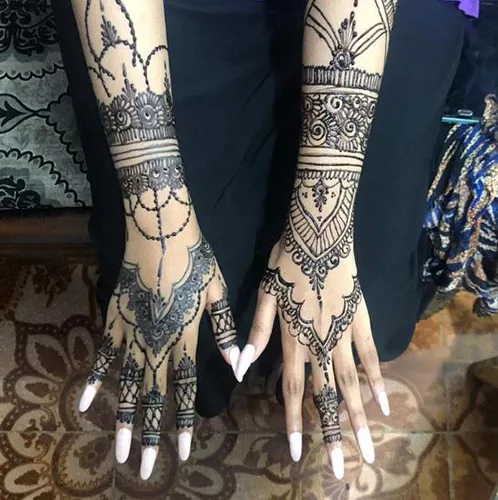Henna Tattoos in Nairobi, Kenya
(Process, Design, Best Placements, Colours, and Considerations)
Henna tattoos, also known as Mehndi tattoos, are temporary body art designs created using henna paste. Henna is a natural dye made from the leaves of the henna plant (Lawsonia inermis). The dye has been used for centuries to create intricate and decorative designs on the skin, especially in South Asia, North Africa, and the Middle East. Henna tattoos are often associated with cultural and religious traditions, as well as celebrations and special occasions.
Henna Tattoos
Henna Tattoo Process
The process of creating and applying a henna tattoo, also known as a Mehndi design, involves several steps. Here’s a general overview of how at Rebel Inks Tattoo Removal and Piercings Parlour we create and do henna tattoos:
Preparation of Henna Paste
- The first step in the process is to prepare the henna paste. This involves drying and crushing henna leaves into a fine powder.
- We will then mix the henna powder with other ingredients such as lemon juice, sugar, and essential oils (e.g., eucalyptus or lavender) to create a thick, smooth paste.
- We then leave the paste to rest for several hours, often overnight, to allow the dye to release and the mixture to mature.
Design Selection
- At Rebel Inks Tattoo Removal and Piercings Parlour we let our clients getting the henna tattoo chooses a design or pattern they’d like to have on their skin. The design can be traditional, cultural, or entirely custom.
Application of Henna
- During the application, your chosen artist will load the henna paste into a cone or applicator, similar to a pastry bag, which is used to draw the design on the skin. Some of our artists use a thin brush or a stick with a fine tip to apply the henna.
- Your artist carefully and skillfully applies the henna paste to the skin, following the chosen design. The application is done freehand, and precision is crucial to create intricate and beautiful patterns.
Drying Time
- After the henna design is applied, it needs time to dry. The drying process can take several hours, typically between 2 to 6 hours or even longer, depending on the desired intensity of the stain.
Wrapping and Sealing
- To protect the drying henna paste and enhance the stain, the design may be wrapped with plastic film or a tissue paper cone. This helps keep the paste in place and creates a warmer, more humid environment, which can intensify the color.
Removal of Paste
- Once the henna paste is completely dry, it will begin to crack and flake off. Gently remove the dried paste by either scraping it off or brushing it away. Avoid washing the area for the first 24 hours, as water can interfere with the dye setting process.
Post-Application Care
- After removing the paste, the design will appear as an orange or light brown stain on the skin. Over the next 24 to 48 hours, the stain will gradually darken.
- To prolong the life of the henna tattoo, avoid water exposure for the first 24 hours and apply a sugar-lemon mixture or an essential oil (like eucalyptus or lavender) to the design.
The final color and duration of the henna tattoo’s stain depend on several factors, including the quality of the henna paste, skin type, and aftercare. With proper care, henna tattoos can last anywhere from a few days to a couple of weeks before gradually fading as the skin naturally exfoliates.
Henna Tattoos Design Techniques
Creating intricate and beautiful Henna Tattoo Designs requires skill and practice. At Rebel Inks Tattoo Removal and Piercings Parlour our Henna artists use various techniques to achieve different styles and patterns. Here are some common henna tattoo design techniques:

Freehand Drawing
Most henna tattoos are created freehand, our artist’s draw the design directly onto the skin without the use of stencils or templates.
This technique allows for greater creativity and customization, as the artist can adapt the design to the your preferences and the body’s contours.
Symmetry
Many traditional henna designs feature symmetrical patterns. At Rebel Inks Tattoo Removal and Piercings Parlour our artist’s often begin by creating a central element, such as a flower or a mandala, and then mirror that element on either side to achieve perfect symmetry.

Paisley Patterns
Paisley or “buta” patterns are a classic henna design element. These teardrop-shaped motifs can be arranged in various ways to create intricate and visually appealing designs.
Floral and Leaf Motifs
Flowers, leaves, and vines are popular elements in henna tattoo designs. These motifs can be used to create beautiful, organic, and flowing patterns. Roses, lotus flowers, and jasmine blooms are often featured in floral henna designs.
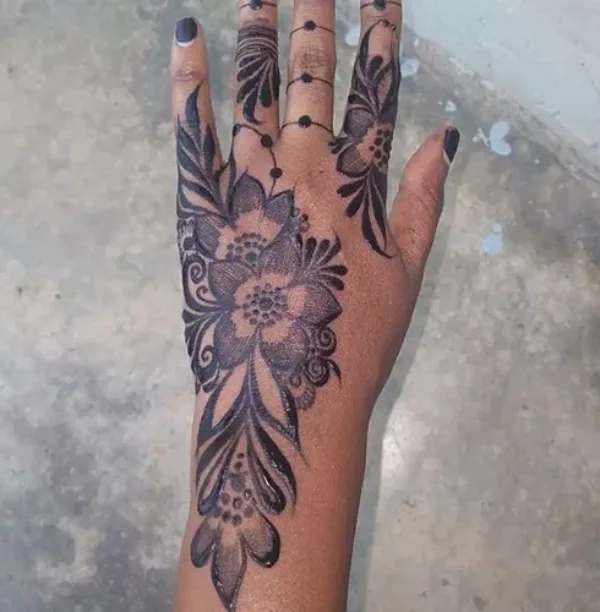


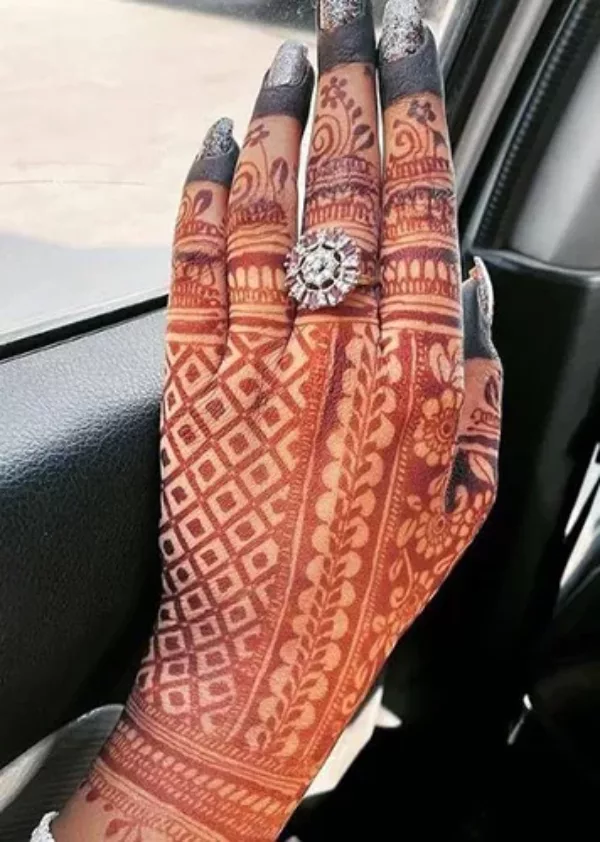


Geometric Patterns
Geometric shapes, such as triangles, squares, and hexagons, can be incorporated into henna designs to create a more contemporary or abstract look. Geometric patterns are often used in combination with other elements to achieve a unique style.
Mandalas
Mandalas are intricate, circular designs that often serve as a focal point for henna tattoos. They can be composed of geometric shapes, floral elements, and fine details to create a mesmerizing effect.
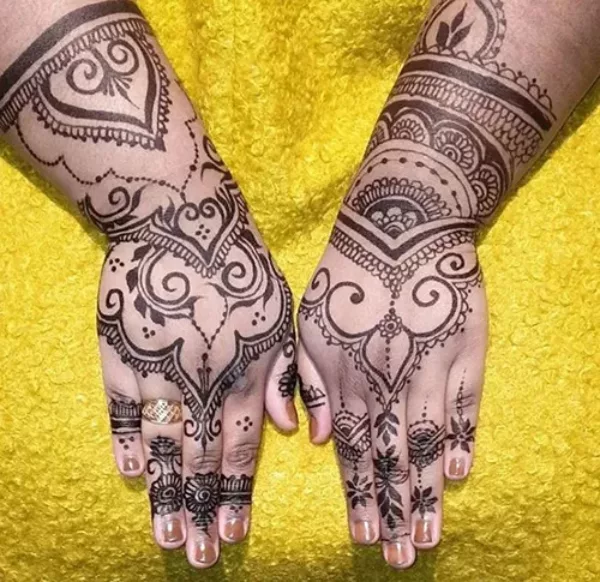


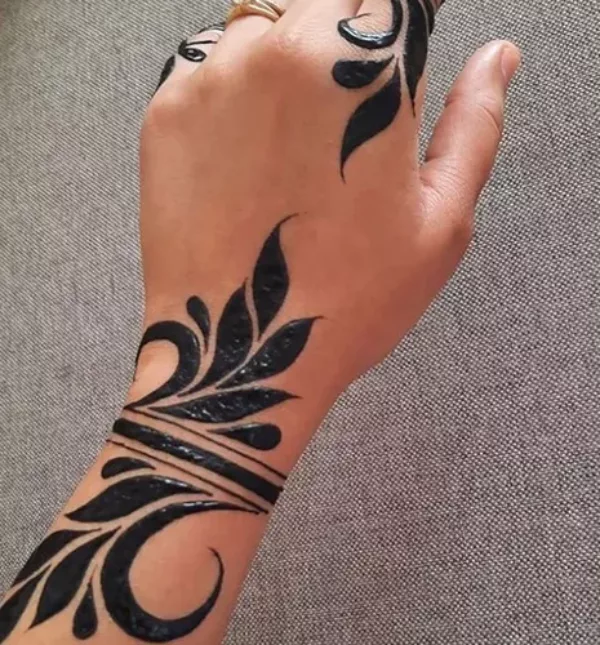


Negative Space
At Rebel Inks Tattoo Removal and Piercings Parlour our artists might use negative space to create contrast and depth in their designs. This involves leaving certain areas of the design empty, which can emphasize the henna-stained areas.
Shading and Layering
At Rebel Inks Tattoo Removal and Piercings Parlour our henna artists can create depth and dimension by using shading techniques. This may involve applying henna more densely in some areas and lightly in others to give the design a three-dimensional appearance.
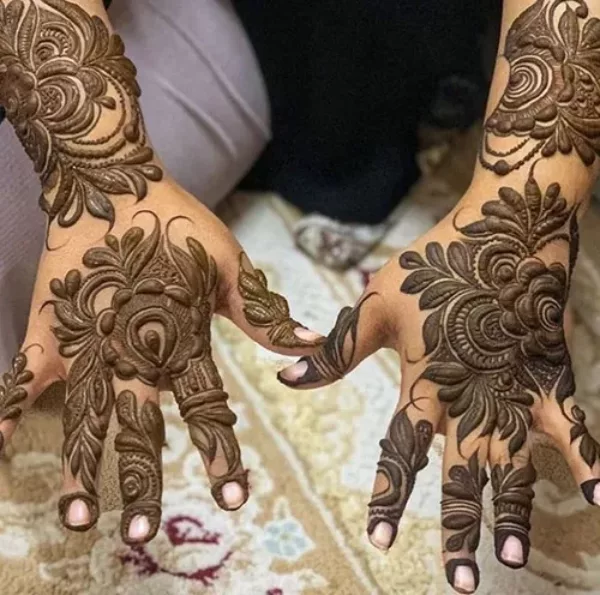


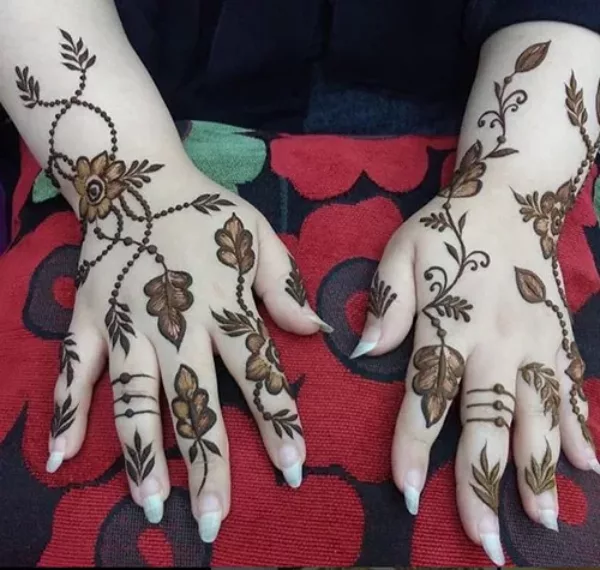


Intricate Filling Patterns
Many henna tattoos feature filling patterns within larger design elements. These can include hatched lines, dots, swirls, or intricate lattices that add texture and visual interest.
Arabic and Indian Styles
Henna designs often draw inspiration from specific cultural traditions, resulting in Arabic and Indian styles. Arabic designs may be more flowing and calligraphic, while Indian designs can be more detailed and intricate.
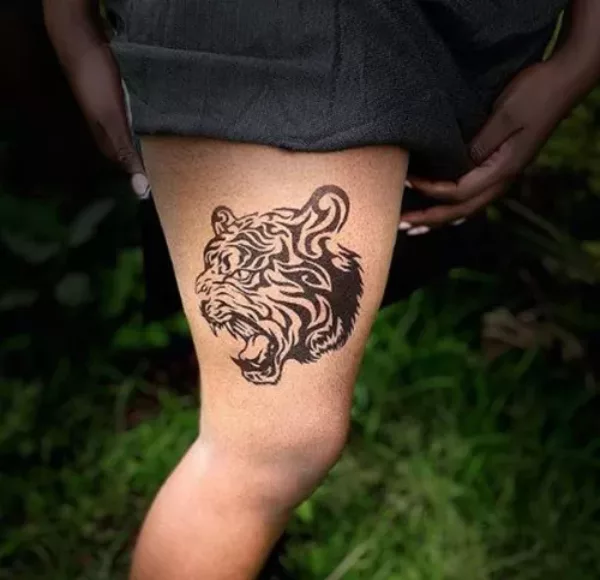


Fusion and Modern Styles
At Rebel Inks Tattoo Removal and Piercings Parlour our artists’ combine elements from different styles or incorporate contemporary themes to create fusion or modern henna designs. These designs often include abstract or non-traditional elements.
Henna artists use a combination of these techniques to create unique and personalized henna tattoos. The key to achieving stunning henna designs is practice and attention to detail, as well as a deep understanding of the cultural and artistic aspects of henna art.
Schedule Appointment
Henna Tattoo Placement
Henna tattoos can be applied to various parts of the body, and the choice of placement often depends on personal preferences, cultural significance, and the specific design being created. Here are some common areas where henna tattoos are typically placed:
- Hands and Fingers: Henna designs on the hands and fingers are among the most traditional and popular placements. Intricate designs on the palms and fingers are often associated with cultural and bridal henna, as they are highly visible and symbolize joy and celebration.
- Feet and Toes: Similar to hands, henna tattoos on the feet and toes are common in many cultural traditions. They are often applied for weddings and festivals. Designs on the feet can be equally intricate and may include anklets and toe rings.
- Forearms and Lower Legs: These areas provide larger canvases for more complex henna designs. The forearms and lower legs are popular choices for extended patterns, including Arabic or Indian motifs, floral designs, and geometric patterns.
- Ankles: Anklets or henna designs around the ankles are a popular choice, especially during warmer months when people wear sandals and open-toed shoes. These designs can be simple or ornate, depending on personal preference.
- Shoulders and Back: For a more discreet or private henna tattoo, the shoulders, upper back, or lower back are often chosen. These placements allow for larger, more decorative designs, such as mandalas or Arabic calligraphy.
- Neck and Collarbone: Henna tattoos on the neck or collarbone area are typically smaller and more delicate. They can include dainty flowers, vines, or meaningful symbols.
- Wrist and Forearm Bands: Henna bands around the wrists or forearms are popular choices for both men and women. These can be simple bands or more elaborate patterns.
- Chest and Cleavage: Some people opt for henna designs on their chest or in the cleavage area for special occasions. These placements can be chosen for a more dramatic look.
- Head and Scalp: In some cultures, henna is also applied to the scalp and hair as a form of natural hair dye or for special rituals. These designs are often more fluid and abstract.
- Face: Henna tattoos on the face are less common but are sometimes chosen for events or festivals. They can include small patterns on the cheeks or forehead.
When deciding on the placement for a henna tattoo, consider the following factors:
- Cultural significance: Some placements have specific cultural meanings or associations.
- Duration: The hands and feet tend to hold henna stains longer due to the thicker skin, while henna on the face and neck may fade more quickly.
- Personal comfort: Choose a placement that you feel comfortable with and that aligns with your personal style and preferences.
Ultimately, the choice of placement for a henna tattoo is a personal one, and there are no strict rules. It’s essential to work with a skilled henna artist who can help you achieve the desired design and placement.
Henna Tattoo Aftercare
Proper aftercare is essential to ensure that your henna tattoo develops a deep and long-lasting stain on your skin. Here are some important aftercare steps to follow:
- Avoid Water for the First 24 Hours: After the henna design is applied, allow it to dry naturally and do not expose it to water for at least the first 24 hours. Water can disrupt the henna’s staining process during this crucial initial period.
- Seal the Design: After the henna paste has dried on your skin, consider sealing the design with a sugar-lemon solution. This mixture is made by combining lemon juice and sugar to create a slightly sticky coating. Apply it over the henna and let it dry.
- Avoid Abrasion: Be gentle with the area where the henna tattoo is located. Avoid rubbing, scratching, or wearing tight clothing that might rub against the design, as this can cause the henna to flake off prematurely.
- Keep the Design Moist: To intensify and prolong the henna stain, keep the design moist. You can do this by applying a natural oil (like eucalyptus or lavender oil) or a balm over the henna design. This will help retain moisture and enhance the color.
- Avoid Chlorinated Water: Chlorinated water, such as that found in swimming pools and hot tubs, can fade henna tattoos more quickly. Avoid prolonged exposure to chlorinated water during the time you want to preserve the henna design.
- Be Cautious with Skincare Products: Be mindful of skincare products you apply to the area where the henna is located. Avoid exfoliating or using harsh chemicals on the skin, as they can contribute to the design fading more quickly.
- Limit Sun Exposure: Sun exposure can also cause the henna tattoo to fade more quickly. If possible, keep the area covered or use sunscreen to protect the design from direct sunlight.
- Let It Naturally Exfoliate: Henna tattoos are temporary, and the design will naturally fade as your skin exfoliates over time. Do not forcefully remove the henna paste or design. Let it wear away naturally.
- Reapply Oil or Balm: As the henna tattoo starts to fade, you can reapply natural oil or balm to help maintain the design’s appearance.
The duration of a henna tattoo’s stain can vary depending on factors like the quality of the henna paste, the thickness of the design, and how well it’s cared for. With proper aftercare, a well-maintained henna tattoo can last anywhere from a few days to a couple of weeks. If you have any concerns about your henna tattoo or experience any adverse reactions, consult a professional henna artist or a dermatologist for guidance.
Henna Tattoo Colours
Henna paste, derived from the henna plant (Lawsonia inermis), typically stains the skin in shades of red-brown to brown. The specific color of a henna tattoo largely depends on various factors, including the quality of the henna paste, the region it’s sourced from, and how long it’s left on the skin. Here are the primary henna tattoo colors:
- Red-Orange to Red-Brown: This is the most common color range associated with henna tattoos. When henna paste is initially applied and then removed after drying, it usually leaves behind a red-orange to red-brown stain on the skin. This color is a result of the natural dye lawsone present in henna leaves.
- Dark Brown: Over time, usually within 24 to 48 hours, the initial orange-red stain deepens to a darker brown, often referred to as “chocolate brown.” This color can be quite rich and is often the desired outcome for intricate henna designs.
- Black Henna (Not Recommended): Some henna products are labeled as “black henna,” but these are typically not made from natural henna. Instead, they may contain additives like para-phenylenediamine (PPD) or other chemicals. Black henna can cause skin reactions, allergies, and should be avoided due to its potential health risks.
- Burgundy and Maroon: Achieving different colors with henna can be done by adding other natural ingredients like indigo, tea, coffee, or cloves to the henna paste. These additives can shift the henna stain toward burgundy or maroon tones.
- Lighter Stains: If henna is left on for a shorter duration or if the paste is not as strong, the resulting stain may appear lighter, with more of an orange tint.
- Natural Variations: Natural variations in the henna plant’s leaves can also affect the color. Henna paste made from freshly harvested leaves may yield different results than paste made from dried leaves, for example.
It’s important to note that the color of a henna tattoo will continue to evolve over the first 24 to 48 hours as the stain oxidizes and deepens. While henna tattoos are generally safe, be cautious when it comes to products labeled as “black henna” or those with undisclosed ingredients, as they may contain harmful chemicals.
For safe and traditional henna tattoos, it’s best to work with experienced henna artists and use high-quality, natural henna paste. If you desire specific colors beyond the typical red-brown spectrum, discuss this with the artist before the application, as they can adjust the henna paste accordingly.
Factors that you should consider when getting a Henna Tattoo
When considering getting a henna tattoo, there are several important factors to keep in mind to ensure a positive experience and a successful outcome. Here are some key considerations:
- Design and Pattern: Choose or discuss the design or pattern you want for your henna tattoo. It’s important to have a clear idea of what you want, whether it’s a traditional design, a custom creation, or a specific style. Make sure the design is meaningful to you. Contact Us and speak to one of our professional artists who will guide you through the design selection process and placement consideration.
- Henna Artist: Select a skilled and reputable henna artist. Look for someone with experience, a portfolio of previous work, and positive reviews. The artist’s expertise will greatly impact the quality of your henna tattoo.
- Safety and Quality: Ensure that the henna paste used is natural and safe. Ask about the ingredients and avoid products labeled as “black henna,” as they may contain harmful chemicals like PPD (para-phenylenediamine). Pure, natural henna should have a reddish-brown hue.
- Allergies and Sensitivities: If you have known allergies or sensitivities, discuss these with your henna artist. Some individuals may be sensitive to certain essential oils or additives in henna paste.
- Placement: Think about where you want the henna tattoo. Consider the design’s size and intricacy in relation to the body part. Some areas may hold the henna stain better than others.
- Duration: Henna tattoos are temporary and gradually fade over time. Consider how long you want the design to last, as this can influence the design and placement decisions.
- Occasion: Determine the occasion or purpose of the henna tattoo. Henna is often used for celebrations, weddings, festivals, or cultural events. The context may influence the design and its significance.
- Aftercare: Be prepared to follow aftercare instructions to maximize the longevity and vibrancy of your henna tattoo. This includes avoiding water for the first 24 hours, sealing the design, moisturizing, and protecting it from abrasion.
- Color Expectations: Understand that the initial color of your henna tattoo may be orange or red, with the color deepening to brown over the first day or two. Discuss your color preferences with the henna artist.
- Budget: Discuss the cost of the henna tattoo with the artist. Prices may vary based on factors such as design complexity, size, and the artist’s experience. At Rebel Inks Tattoo Removal and Piercings Parlour we have a flexible price range suited for your specific design and placement, Contact Us Today to learn more
- Cultural Sensitivity: If you’re getting a henna tattoo that has cultural or religious significance to a particular community, be respectful of its cultural context and meaning.
- Communication: Open and clear communication with the henna artist is essential. Discuss your ideas, expectations, and any questions or concerns you may have before the application.
- Skin Health: Ensure that the area where the henna will be applied is clean and free from skin conditions or irritations.
- Lifestyle Considerations: Think about your daily activities and lifestyle, as some may affect the longevity of your henna tattoo. For example, swimming in chlorinated pools may cause the design to fade more quickly.
Get In Touch
For more information on the list above and any other special services,please call or come in for free consultation
Testimonials
After he pierced my industrial piercing and seeing his amazing work, I feel even more excited about getting my tattoo with him in January. I’m really looking forward to it!
I am extremely happy with my new 'Safari' tattoo from Eric at Rebel Inks! The quality of the artwork is fantastic. Eric is a true professional and an amazing artist.
The preparation and design process was thorough and collaborative. He was very patient with my specific requests, including making sure all the elements, which hold personal meaning, were perfect.
The service was friendly and highly professional from start to finish. Despite the 8-hour session, Eric was a pleasant person to spend the time with.
The aftercare guidance and follow-up have been excellent and careful, which has made the healing process easy and better than expected.
I highly recommend Eric for anyone looking for a thoughtful, talented, and caring tattoo artist.
I recommend them 💯
I would definitely recommend if you’re thinking of getting a piercing!
The staff were super friendly, explained everything clearly, and made me feel so at ease. They answered all my nervous questions (and I had many questions),
They walked me through the whole process, gave detailed aftercare instructions, and even followed up afterward to check how I was healing 🫶
Clean, professional, and full of good vibes.
Would 100% recommend . Definitely making a second trip here.
This was the second tattoo I got and I wish I could have come to Eric for my first one! He gave me really great after-care directions for the tattoo as well as a little jar of his own Vaseline-type stuff to put over my tattoo while it was healing! He even put second skin over my tattoo so that I didn’t have to worry about it for the first few days. Now THAT’S good service. My first tattoo artist didn’t do none of that lol.
After the session Eric didn’t rush me and my friend out, he chatted with us and even when he found out I was an artist too— really encouraged me to keep creating and to find a community of artists to support me. I almost cried because I’ve had such a hard time with my own art the past couple of years, it meant so much to me to have a fellow very talented artist say that to me. 🤍🤍🤍
Eric you’re amazing, don’t ever stop creating and just know you’ve impacted lives all over the world!🫶🏻 thanks so much for everything!!
From the moment I walked in, Eric was professional, welcoming, and attentive. He made sure I was comfortable throughout, provided everything I needed, and explained every step of the process. The tattooing itself was unbelievably smooth - I genuinely felt no pain compared to my previous tattoos over the last 22 years.
Eric also gave me excellent aftercare guidance and products, and thanks to that, my tattoo healed beautifully. The attention to detail, precision, and shading are absolutely stunning. This is hands-down the best tattoo I've ever had, and I will be flying back to Nairobi for any future ink.
If you want incredible art, a professional experience, and a talented artist who truly cares about his clients, Rebel Ink is the place to go!
From start to finish, the service was exceptional. The piercer was professional, knowledgeable, and made me feel completely comfortable. The cleanliness of the place was above and beyond — everything was spotless and hygienic, which really put me at ease. Highly recommend for anyone considering a piercing!
Shout out to Eric😘
We ended up changing the jewelry three times to ensure I had the best fit and avoided any signs of rejection, and he always listened to my suggestions as a client, which I really appreciated. Now, three months in, my piercing is healing beautifully, with no sign of rejection. Highly recommend for anyone who values a piercer who cares about your comfort and healing journey!
What stood out the most was the aftercare Eric checked in with me even three weeks later to see how the tattoo was healing. That kind of follow-up shows how much he truly cares about his work and his clients.
I’m very satisfied and will definitely be coming back for my next piece. Highly recommend!
The piercing wasn't as painful as I had thought and the process was quick and satisfactory. I love it!!!
The piercing is healing well thanks to the aftercare instructions and follow-up. I would highly recommend Rebel Inks
Eric also did a belly button piercing for a friend, guiding her through the process, doing the piercing and then explaining the after care to her.
The shop is on the 3rd floor, with the entrance to the stairs near an alleyway on the left. The shop is perfect size, clean, and attractive looking. The mural is pretty dope.
Thank you for the amazing service! 🔥👅✨
I got piercibgs there and the process was really good. My biggest concern was hygiene but that wasn't an issue at all, they use new needles and they sanitize them.
The service itself was also welcoming.
I was informes of everything i needed to know beforehand.
10/10 would recommend!
Eric was so calm and patient with my almost 2 year old lady. It was such a clean and hygienic process. We will definitely be back for our second rounds of piercings and maybe even another tattoo!
They assess the area before any art and advise one accordingly. They also give one post clean up process and also do a check up after the body art projects. Overall, I loved my experience and I’m hooked. 👍
Will definitely come back next time I’m in town 🙂
He listened to what I actually wanted and made sure he could fit in the time before I flew back home.
The shop is clean & private and is easy enough to find.
Eric has even checked in a couple of times since to make sure all is good.
I would totally recommend Eric! I absolutely love my Elephants!
I had a very easy healing period and always follow up from Eric to check on my progress...I would highly recommend if you are a first timer because from my experience all went very well and attention to detail
Thank you for a good job and looking forward to send all my friends your way
And all the best with the new year 2025!
From the moment I walked in, the staff was super friendly and made me feel at ease. The studio had a clean, professional atmosphere, which immediately put me at ease. My piercer was incredibly skilled and explained every step of the process, ensuring I was comfortable the entire time. The piercing was quick and practically painless, and the aftercare instructions were clear and easy to follow. I can tell they really care about the health and safety of their clients.
Overall, a fantastic experience—I highly recommend Rebel Inks and Tattoos for anyone looking to get pierced or tattooed!
They do follow up after their services
Eric's Studio isn’t just a place to get a tattoo—it’s an experience. The combination of professionalism, artistic talent, and a welcoming environment makes it a standout destination for anyone considering a tattoo.
I highly recommend Eric’s Studio to both first-timers and seasoned tattoo enthusiasts. If you’re looking for a high-quality tattoo and an enjoyable experience, this is the place to go.
I would definitely recommend their services again and again
Thank you Rebel Ink
My piercings are healing ❤️🩹 well
I would 💯 recommend
I will definitely come back for more .
Two, all the equipments he used for the piercings were new and/or sterilised.
Three, the parlour itself was very clean and was up to par with the hygiene standards.
Four, Eric provided effective aftercare instructions, making sure I knew exactly how to take care of my new piercings and he kept in touch and continues to do so, to check on the healing progress.
I highly highly highly recommend this place!!!
Would definitely recommend them to friends and go back for other piercings
Not only was the piercing process smooth, but he also provided thorough aftercare instructions, making sure I knew exactly how to take care of my new piercings. What really impressed me was that he keeps in touch to check on how the healing is progressing – a sign of true care for his clients.
The shop maintains a high standard of hygiene, and the atmosphere is welcoming and comfortable, which really added to the positive experience. I highly recommend this place to anyone looking for a professional and caring experience. I’ll definitely be coming back for any future piercings!
My appreciation for the excellent customer service I received. The follow-ups were prompt, and I truly appreciated the gentleness and professionalism throughout. Thank you!"
"Looking for professional eyebrow microshading removal? Look no further!"
The customer care is top tier 👌🏾👌🏾.
Wonderful place to get tattoos and piercings. 💯💯
Eric goes ahead to follow up on his clients progress and gives good advice each time I reach out to him.
I would recommend Reble tattoos anytime.
Good job bro we really appreciate.
Ohh and the price is very fair.
The environment was clean , procedure was sterile and the jewelry used are of the best quality.
He followed up with me during the healing process, he educated me on what I needed to do for my aftercare.
Eric is confident, skilled , experienced and the best piercer. Highly recommend Rebel inks.✨
Definitely recommend!
Great experience.
Eric definitely know what he is doing .
I got exactly what I wanted 2 tiny tats on the same finger .
He was kind and patient throughout the session.
Healing process has been good .
Aftercare services were given and regular checkups on the healing process were done.
I would 💯recommend.
Eric gave me the best reception as it was my first time there,and made me trust him all the way. I appreciate good services.
There services are also affordable not to forget 😊.
He was also invested in the aftercare and would ensure I follow the do's and don'ts in taking care of the tattoo and ensuring proper healing and maximum ink retention.
Would highly recommend Rebel Inks Tattoos.
Rebel Inks Tattoo offer the best,affordable and quality tattoo removal services.If you have unwanted ink,choose Rebel Inks Tattoo,they're the best of the best and the professionalism is a top notch.They ensure you're free from unwanted ink with their Laser Tattoo Removal Technology...
I did a Laser Tattoo Removal with them and i can attest they're the best....
Kudos Eric...
I highly recommend.
It was a generally good experience with good hygiene during the piercing process and has been a smooth healing process.... 10/10
tips. Highly recommend 👍🏽
100% recommendable.
I was particularly impressed with Eric's attention to hygiene. He thoroughly cleaned the room before I entered, sanitized all of the equipment he would be using, and changed gloves between each ear. This level of cleanliness gave me great confidence in his professionalism.
Eric's commitment to customer service did not end on the day of the piercing. He followed up with me regularly throughout the healing process to ensure that I was following the aftercare instructions and that my earlobes were healing properly.
I highly recommend Rebel Inks to anyone in Nairobi who is considering getting a piercing. Eric is a highly skilled and experienced piercer who takes great pride in his work.
So I Check all the boxes below and more:
Customer Care: ✔️
Professionalism : ✔️
Cleanliness ✔️
Price: ✔️
After care service ✔️
Thanks and good job, Eric
The place is neat and clean and the equipments he used were also fine standards. Really appreciate his following up with me on the healing 🤗
I WOULD HIGHLY RECOMMEND THEIR SERVICES to everyone. Actually what you see on their website is EXACTLY what you will get. Keep up the good work Rebel inks Tattoos.
The infection is now gone. I would definitely recommend!
Can recommend this place totally and would go back there anytime!
Thanks!
OUR LOCATION
Areas We Serve
NAIROBI
KIAMBU
KAJIADO
MACHAKOS

